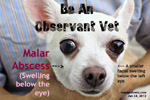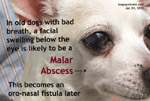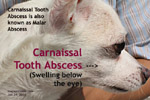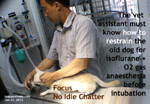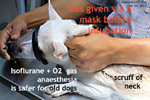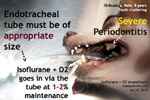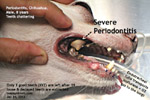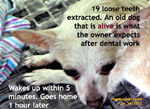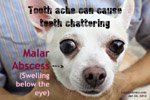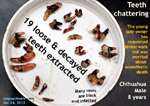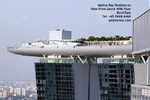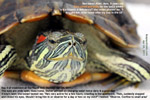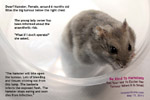Teeth chattering in dogs. AUDIO CLIP
Image of THE CHIHUAHUA
Snow fall --- cold winter, snow-storm, but this is sunny Singapore
Antagonist arriving? Big bear attack when walked near the forest?
Loud noise --- fall from the sky, a meteor, earthquake tremors - 6th sense
A dog catcher on the prowl with his net? Downhill wind scent
A female dog nearby? Scent
INTRODUCTION
the case of the teeth-chattering Chihuahua
Dr Sing Kong Yuen, BVMS (Glasgow), MRCVS
25 January, 2012
What causes it? The owner with the 8-year-old Chihuahua was a fair young lady probably had done her internet research and one of the websites would be:
http://answers.yahoo.com/question/index?qid=20100126080555AAfbVSv
|
AN EDUCATION
VIDEO FOR VET STUDENTS AND PET OWNERS COMMUNITY EDUCATION FROM TOA PAYOH VETS --- toapayohvets.com Singapore, Jan 24, 2012 |
MIDDLE
CAUSES OF TEETH CHATTERING
1. Behaviour? Nervous, excitement. (Video clip of
chattering). Not for her dog as this teeth chattering
was recent and her dog was a calm and cool canine
since young. When I saw her, the Chihuahua never
chattered his teeth! Cool as a cucumber, the older
Englishman would say. The google generation like this
owner would say: "So cool!"
2.Cold freezing weather? (Slide of winter, snow fall)
Not in Singapore. It is Summer season all year round.
3. Certain breeds suffer from nervous disorder e.g.
seizures, neuronal degeneration in young Cocker
Spaniels or other breeds, white dog shaker syndrome in
white dog breeds such as West Highland white terriers,
the Maltese and the Bichon Frise. This needs early
veterinary consultation.
4. Dental pain? This would be the likely cause as the
old dog had bad breath, gum infections and loose
decayed teeth. So she brought her dog to her vet as
she felt that the recent teeth chattering could be due
to toothache. Her vet wanted her to sign an
anaesthetic risk consent form and forewarned her that
her dog was an older dog and might die on the
operating table during dental work.
|
CASE OF THE
TEETH-CHATTERING CHIHUAHUA FIRST VISIT Sunday, January 15, 2012 |
The young couple
came with the Chihuahua after having consulted a vet
earlier. Death on the operating table is the main
concern with the fair lady. Vet 1 had insisted that
they sign the anaesthetic consent form highlighting
the risk of death in an old dog undergoing dental
work. "This is the common practice," I explained.
"Even the human hospitals will ask you to sign the
form if you go for anaesthesia and surgery. In the
Singapore General Hospital, I was even given a
10-minute talk on anaesthetic risk by a young doctor
in a room as I was scheduled for surgery the next
week."
Her biggest worry and that of her mum was anaesthetic
death. The vet must listen to what the client has to
say. How competent is the vet? She does not know.
"How many anaesthetic deaths have you encountered when
you did dental scaling?" she asked my associate vet
who was handling the examination together with me.
This was the sort of question many internet websites
have advised the dog owner to ask the doctor. My
associate vet said: "I refer you to Dr Sing."
The young lady turned her head to me for an instant
reply.
I said: "I can only speak for myself. In my over 30
years of dental scaling, I have not encountered any
anaesthetic death. This is because dental scaling and
work do not require long anaesthesia. Therefore the
risk of deaths on the operating table is very low. The
anaesthesia should be completed within 15 minutes.
Careful monitoring of the vital signs by the vet is
most important."
I don't permit idle chatter during dental surgery. Nor
do I make small talk with my assistant during
surgeries. A singular focus on the surgery. Speed
accuracy and completeness.
"Look at the right face," I pointed to the facial
swelling. "Do you see a big swelling below the eye?
The bacteria from the root of the back teeth, the 4th
premolar, had gone into the face, causing this
swelling. It is called a malar abscess."
The lady had a second look at the right face. "Compare
to the left area below the eye," I suggested. "There
is no swelling there!"
The lady turned her head to inspect the left face.
This new finding added to her worries. She knew a
dental work under general anaesthesia was necessary.
Dental gels and paste that claim to work would not be
effective. The internet advertisements of pet teeth
are products are many.
Warnings of high anaesthetic risks and death esp. for
the older dogs flashed back into her mind. She was
well educated and informed to know that such products
would not work for her dog.
|
ALTERNATIVE TREATMENTS WITHOUT ANAESTHESIA 1. Oral care gels and paste, chew toys and kibbles? 2. No anaesthesia dog groomers. Need to hold the dog firmly and rigorously to do the scaling or extraction as most dogs fight against such dental work without sedation and are frightened of it. 3. No action from the owner. Leads to oro-nasal fistula as in another Chihuahua. Show clips from 1. Chihuahua with a non-healing facial wound - oro-nasal fistula http://www.youtube.com/watch?v=5AWHpWYWgy4&lr=1 2. Follow up on the Chihuahua after surgery and pyometra death http://www.youtube.com/watch?v=ExTT2a8eUCs |
How about dog groomers offering dental scaling without
anaesthesia? There are such services offered by some
pet shops in Singapore. This was an educated owner in
my assessment, probably having completed higher
education level and knows the situation.
She had done her internet research and knew that her
dog would need more than dental scaling. He needed to
have his loose and decayed teeth extracted. And this
could not be done by the dog groomer without
anaesthesia.
Her vet insisted that she signed the anaesthetic form
first as taught by their veterinary professors to
cover their back in case of litigation.
Here, at Toa Payoh Vets, my vets do insist on the
client signing the anaesthetic form too. For me, I
don't insist on it after explaining in detail
one-to-one the risks and benefits thoroughly. So, I
seldom get the owner to sign the form as this cause
considerable stress for some of the young ones over my
past 40 years of practice. If the client has no
confidence in me, I would suggest going to another
vet.
For this case, I advised antibiotics for the next few
days and getting the dental work done on Friday as
Sunday would be Chinese New Year. I don't perform
surgery on Chinese New Year although I am not
superstitious about bad luck if the vet "cuts" on
Chinese New Year.
I told my associate vet that I would be handling the
case myself as there was great worries for the fair
lady.
|
SECOND
VISIT Friday, January 20, 2012 |
Sunday will be Chinese New Year's Eve. So the dog was
done today. Blood test taken revealed nothing
abnormal. "You have checked the blood test?" the young
lady asked me. "Yes, the blood test showed normal
results. There is no kidney or liver disorders and the
dog's heart is good. Come back 2-3 hours later." She
was comforted and left with her significant other.
|
ISOFLURANE + OXYGEN ANAESTHESIA Chihuahua, Male, 8 years, Severe stage 4 periodontal disease. No sedation Images of the process and procedures |
Mask and then intubation. Many assistants don't know
how to anaesthesize the dog using just isoflurane + O2
as the dog does struggle vigorously and bite at a
certain stage.
The technique is to hold the dog by the scruff of the
neck and to take out the mask when the dog struggles
at the excitement stage. Wait a few seconds and put
the mask on. Repeat again. Normally, the dog will be
anaesthesized smoothly.
Ideally, the dog should be sedated, given isoflurane
by mask and then intubated. This is the better
restraint and saves much time as the excitement stage
does not exist. Most vets use this method and this is
the method taught by the veterinary professors. I
don't know whether they teach the use of isoflurane
solely in old dogs or not as I was a student 40 years
ago.
In this case, the owner had some knowledge of the sole
use of isoflurane gas done by me and asked me about
it. So I took over this case from my associate vet to
give her peace of mind. Usually dental scaling is a
relatively easier surgery compared to others like
spay.
An endotracheal tube of the appropriate size, not too
small, is inserted and the dog given 1-2% isoflurane
gas as maintenance. The proper sized endotracheal tube
for this dog was 6.5
Only 3 teeth left. Around 16 extracted.
The dog coughed when the owners came to pick up 2
hours later.
"It is caused by throat irritation of the endotracheal
tube," I explained. "I inserted the tube into the
windpipe to give the anaesthetic gas. I will give an
injection."
It was one of those satisfying moments to see the
young lady smile and freed of worries since her
Chihuahua had not died on the op table and was as
alert as if he had not been under anaesthesia.
Isoflurane anaesthesia effect disappears within 5
minutes and that is why this dog was as alert as
normal.
However, it takes a longer time to anaesthesize the
dog and there is a certain technique which I taught my
assistant Min so as not to injure the dog when he is
struggling before being asleep. If a sedation
injection is given first, there is virtually no
struggling. As I had promised the owner that I will
use gas only, I kept my word.
CONCLUSION
Anaesthetic deaths during dental scaling are rare in
practice. Anaesthetic consent forms worry many owners
and the risk of anaesthetic deaths promote a window of
opportunity for non-veterinarians to provide dental
scaling services.
Regular dental check up once a year and tooth brushing
would have prevented the loss of 19 teeth and much
worries. Do spend time brushing your dog's teeth at
least three times a week. Easier said than done. A
vast majority of Singapore owners is too busy to do
the dental brushing.
CREDITS
|
COMMUNITY
EDUCATION FROM TOA PAYOH VETS ---
toapayohvets.com
|
 TOA
PAYOH VETS
TOA
PAYOH VETS

